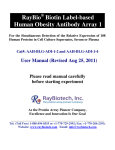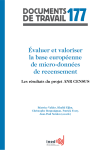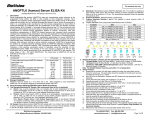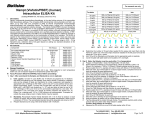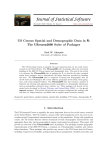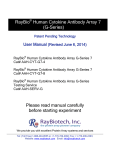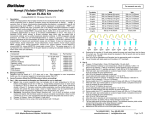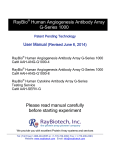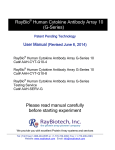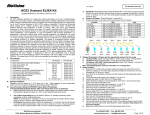Download ANGPTL3 (mouse/rat) Serum ELISA Kit
Transcript
BioVision ANGPTL3 (mouse/rat) Serum ELISA Kit I. II. (Catalog #K4915-100; 100 assays; Store kit at 4°C) Description: The angiopoietins are a family of growth factors that are specific for vascular endothelium. The full-length cDNA encoding angiopoietin-like protein 3 (ANGPTL3) from a human fetal liver/spleen cDNA library has 460-amino acid and the characteristic structure of angiopoietins: a signal peptide, an extended helical domain predicted to form dimeric or trimeric coiled-coils, a short linker peptide, and a globular fibrinogen-like domain (FLD). Human ANGPTL3 shares 76% amino acid sequence identity with mouse Angptl3. Northern blot analysis of human tissues showed a preferential expression of 4 ANGPTL3 transcripts being 4.5, 3.0, 2.8, and 1.7 kb in liver. ANGPTL3 can induce angiogenesis in the rat corneal assay. The FLD alone was sufficient to induce endothelial cell adhesion and in vivo angiogenesis. Microarray analysis showed that mouse hematopoietic stem cell (HSC)-supportive fetal liver CD3-positive cells expressed Angptl2 and Angptl3. The ANGPTL3 ELISA Kit is to be used for the in vitro quantitative determination of mouse/ rat ANGPTL3 in biological fluids. This assay is a sandwich Enzyme Linked-Immunosorbent Assay (ELISA) for quantitative determination of mouse or rat ANGPTL3 in biological fluids. A polyclonal antibody specific for ANGPTL3 has been precoated onto the 96well microtiter plate. Standards and samples are pipetted into the wells for binding to the coated antibody. After extensive washing to remove unbound compounds, ANGPTL3 is recognized by the addition of a biotinylated polyclonal antibody specific for ANGPTL3 (Detection Antibody). After removal of excess biotinylated antibody, HRP labeled streptavidin (Detector) is added. Following a final washing, peroxidase activity is quantified using the substrate 3,3’,5,5’tetramethylbenzidine (TMB). The intensity of the color reaction is measured at 450 nm after acidification and is directly proportional to the concentration of ANGPTL3 in the samples. The assay range is 0.016 – 1 ng/ml ANGPTL3/ml. The lowest level of ANGPTL3 that can be detected by this assay is 15 pg/ml. Kit Contents: Component For research use only rev. 1/15 100 Assays Part Number 1 plate coated with mouse ANGPTL3 Antibody 6x16-well strips K4915-100-1 2x30 ml K4915-100-2 2 bottle Wash Buffer 10X 2x30 ml K4915-100-3 2 bottle ELISA Buffer 10X 30 μl K4915-100-4 1 bottle Detection Antibody 1 vial K4915-100-5 1 vial Detector (HRP Labeled Streptavidin, 2 μg) 1 vial K4915-100-6 1 vial mouse ANGPTL3 Standard (lyophilized, 2ng) 12 ml K4915-100-7 1 bottle TMB Substrate Solution 12 ml K4915-100-8 1 bottle Stop Solution 2 K4915-100-9 2 plate sealers (plastic film) III. Storage Conditions: Reagents must be stored at 2 - 8°C when not in use. Bring reagents to room temperature before use. Do not expose reagents to temperatures greater than 25°C. IV. Assay Procedure (Read the ENTIRE Protocol Before Proceeding) 1. Test Samples/Standards/QC Sample: (We recommend these be run in duplicate) a) Serum: Use a serum separator tube. Let samples clot at room temperature for 30 min before centrifugation for 20 min at 1000 x g. Assay freshly prepared serum or store serum in aliquots at -20°C for future use. Avoid repeated freeze/thaw cycles. b) Plasma: Collect using heparin, EDTA or citrate as an anticoagulant. Centrifugation for 15 min at 1000 x g within 30 min of collection. Assay freshly prepared plasma or store in aliquots at -20°C for future use. Avoid repeated freeze/thaw cycles Note: Serum, Plasma, Urine or Cell Culture Supernatant has to be diluted in Diluent 1X. Samples containing visible precipitates must be clarified before use. As a starting point, 1/4000 dilution of mouse samples and 1/400 dilution of rat samples are recommended. c) QC Sample: Reconstitute Mouse ANGPTL3 QC sample with 1 ml of dH2O. Mix the QC Sample to ensure complete reconstitution. Allow to sit for a minimum of 15 min. The QC Sample is ready to use- do not dilute it (refer to the C of A for current QC Sample concentration). BioVision Incorporated 155 S. Milpitas Boulevard, Milpitas, CA 95035 USA d) e) Standards: Reconstitute mouse ANGPTL3 Standard with 1 ml of dH2O to produce a stock solution (2 ng/ml). Mix the Stock solution to ensure complete reconstitution. Allow to sit for a minimum of 15 min. The reconstituted standard should be aliquoted and stored at -20°C. Prepare Standard Curve using 2-fold serial dilutions with 1X ELISA Buffer To obtain 1 ng/ml 0.5 ng/ml 0.25 ng/ml 0.125 ng/ml 0.063 ng/ml 0.031 ng/ml 0.016 ng/ml 0 ng/ml 300 µl 2 ng/ml Add 300 µl of ANGPTL3 (2 ng/ml ) 300 µl of ANGPTL3 (1 ng/ml ) 300 µl of ANGPTL3 (0.5 ng/ml ) 300 µl of ANGPTL3 (0.25 ng/ml ) 300 µl of ANGPTL3 (0.125 ng/ml ) 300 µl of ANGPTL3 (0.063 ng/ml ) 300 µl of ANGPTL3 (0.031 ng/ml ) 300 µl of Diluent 1X 300 µl 1 ng/ml 0.5 ng/ml 300 µl 0.25 ng/ml 300 µl 0.125 ng/ml 300 µl Into 300 μl of 1X ELISA Buffer 300 μl of 1X ELISA Buffer 300 μl of 1X ELISA Buffer 300 μl of 1X ELISA Buffer 300 μl of 1X ELISA Buffer 300 μl of 1X ELISA Buffer 300 μl of 1X ELISA Buffer Empty tube 300 µl 0.063 ng/ml 300 µl 0.031 ng/ml 0.016 ng/ml 0 ng/ml 2. Reagent Preparation: (Prepare just the appropriate amounts for the assay) a) 1X Wash Buffer: Dilute 10X Wash Buffer 1: 9 with dH2O to obtain 1X Wash Buffer. b) 1X ELISA Buffer: Dilute 10X ELISA Buffer 1: 9 with dH2O to obtain 1X ELISA Buffer. c) Detection Antibody: has to be diluted to 1:500 in ELISA Buffer 1x. Note: The diluted Detection Antibody is not stable and cannot be stored! d) HRP Labeled Streptavidin: has to be reconstituted with 200 µl of ELISA Buffer 1X. prepare aliquots and store them at -20°C. Avoid freeze/thaw cycles. Dilute the reconstituted STREP-HRP to the working concentration by adding 50 µl in 10 ml of ELISA Buffer 1X (1:200). Note: The diluted STREP-HRP is not stable and cannot be stored. IV. Assay Protocol: a) Determine the number of 16-well strips needed for assay and insert them into the frame for current use. The extra strips should be resealed in the foil pouch and can be stored at 4°C for up to 1 month. b) Add 100 μl of the Standards, and Samples into the appropriate wells in duplicate. c) Cover plate with plate sealer and incubate for 1 hr at 37°C. d) Aspirate and wash 3 times with 300 μl of 1X Wash Buffer. Completely remove the liquid. e) Add 100 μl detection antibody into each well. f) Cover plate with plate sealer and incubate for 1 hr at 37°C. g) Aspirate and wash 3 times with 300 μl of 1X Wash Buffer. Completely remove the liquid. h) Add 100 μl of diluted STREP-HRP into each well. i) Cover plate with plate sealer and incubate for 1 hr at 37°C. j) Remove plate from 37°C, aspirate and wash 5 times with 300 μl of 1X Wash Buffer. k) After last wash, tap inverted plate on a stack of paper towels. Complete removal of liquid is essential for good performance. l) Add 100 µl to each well of TMB Substrate Solution. m) Allow the color to develop at room temperature in the dark for 10 min. n) Stop the reaction by adding 100 μl of Stop Solution to each well. o) Tap the plate gently to ensure thorough mixing. The substrate reaction yields a blue Tel: 408-493-1800 | Fax: 408-493-1801 www.biovision.com | [email protected] Page 1 of 2 BioVision V. a) b) c) d) For research use only rev. 1/15 solution that turns yellow when Stop Solution is added. Caution: Stop Solution is a Corrosive Solution p) Measure the OD at 450 nm in an ELISA plate reader within 30 min. Calculations: 4. Average the duplicate readings for each Standard, QC Sample and Test Sample and subtract the average blank value (obtained with the 0 ng/ml point). Generate a Standard Curve by plotting the average absorbance on the horizontal (X) axis vs. the corresponding concentration (µg /ml) on the vertical (Y) axis. (See Typical Data below) Calculate the Test Sample ANGPTL3 concentrations by interpolation of the Standard Curve regression curve as shown below in the form of a quadratic equation. If the Test Samples were diluted, multiply the interpolated values by the dilution factor to calculate the corrected mouse or rat ANGPTL3 concentrations. Expected values: ANGPTL3 levels range in mouse samples from 50 to > 1,000 ng/ml. ANGPTL3 levels range in rat samples from 10 to > 150 ng/ml Technical Hints and Limitations: It is recommended that all standards, QC sample and samples be run in duplicate. Do not combine leftover reagents with those reserved for additional wells. Reagents from the kit with a volume less than 100 µl should be centrifuged. Residual wash liquid should be drained from the wells after last wash by tapping the plate on absorbent paper. Crystals could appear in the 10X solution due to high salt concentration in the stock solutions. Crystals are readily dissolved at room temperature or at 37°C before dilution of the buffer solutions. Once reagents have been added to the 8-well strips, DO NOT let the strips DRY at any time during the assay. Keep TMB Substrate Solution protected from light. The Stop Solution consists of sulfuric acid. Although diluted, the Stop Solution should be handled with gloves, eye protection and protective clothing. Troubleshooting: PROBLEM VI. 1. Performance Characteristics: Intra-assay precision: Six samples of known concentrations of mouse and rat ANGPTL3 were assayed in replicates 10 times to test precision within an assay. Samples 1 2 3 4 5 6 Mean 512.29 481.98 509.66 391.49 502.42 818.34 SD 19.07 17.94 25.32 23.03 21.19 37.33 CV (%) 3.72 3.72 4.97 5.88 4.22 4.56 n 10 10 10 10 10 10 2. Inter-assay precision: Five samples of known concentrations of mouse and rat ANGPTL3 were assayed in 5 separate assays to test precision between assays. Samples 1 2 3 4 5 Mean 555.19 439.08 487.63 63.78 778.45 SD 32.61 27.65 38.82 4.32 39.49 CV (%) 5.87 6.3 7.96 6.78 5.07 n 5 5 5 5 5 POSSIBLE CAUSES SOLUTIONS Omission of key reagent Check that all reagents have been added in the correct order. Washes too stringent Use an automated plate washer if possible. Incubation times No signal or weak inadequate signal Plate reader settings not optimal Incorrect assay temperature High background Poor standard curve Unexpected results Incubation times should be followed as indicated in the manual. Verify the wavelength and filter setting in the plate reader. Use recommended incubation temperature. Bring substrates to room temperature before use. Concentration of detector too high Use recommended dilution factor. Inadequate washing Ensure all wells are filling wash buffer and are aspirated completely. Wells not completely aspirated Completely aspirate wells between steps. Reagents poorly mixed Be sure that reagents are thoroughly mixed. Omission of reagents Dilution error Be sure that reagents were prepared correctly and added in the correct order. Check pipetting technique and double-check calculations. 3. Recovery: When samples (serum) are spiked with known concentrations of mouse and rat ANGPTL3, the recovery averages 100% (range from 90% to 110%). Samples 1 2 3 Average Recovery (%) 93.85 98.63 109.56 Range (%) 90-100 95-105 105-110 BioVision Incorporated 155 S. Milpitas Boulevard, Milpitas, CA 95035 USA FOR RESEARCH USE ONLY! Not to be used on humans. Tel: 408-493-1800 | Fax: 408-493-1801 www.biovision.com | [email protected] Page 2 of 2


